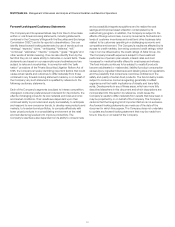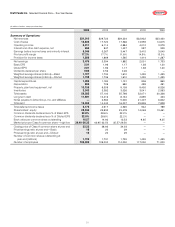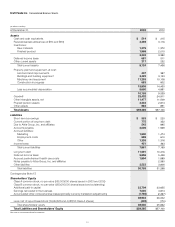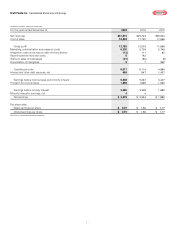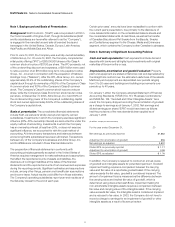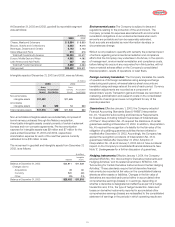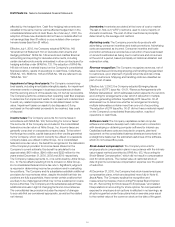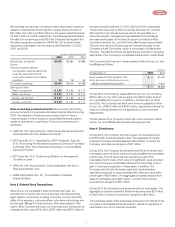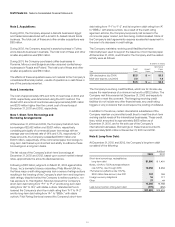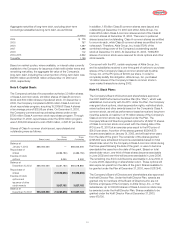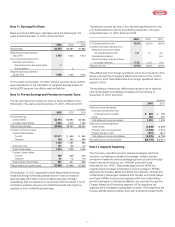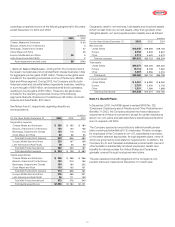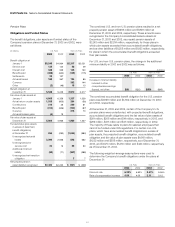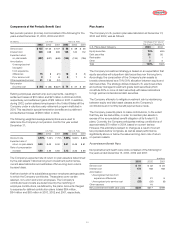Kraft 2003 Annual Report Download - page 48
Download and view the complete annual report
Please find page 48 of the 2003 Kraft annual report below. You can navigate through the pages in the report by either clicking on the pages listed below, or by using the keyword search tool below to find specific information within the annual report.
46
Kraft Foods Inc. Notes to Consolidated Financial Statements
affected by the hedged item. Cash flow hedging instruments are
classified in the same manner as the affected hedged item in the
consolidated statements of cash flows. As of January 1, 2001, the
adoption of these new standards did not have a material effect on
net earnings (less than $1 million) or accumulated other compre-
hensive losses (less than $1 million).
Effective July 1, 2003, the Company adopted SFAS No. 149,
“Amendment of Statement 133 on Derivative Instruments and
Hedging Activities.” SFAS No. 149 amends and clarifies financial
accounting and reporting for derivative instruments, including
certain derivative instruments embedded in other contracts and for
hedging activities under SFAS No. 133. The adoption of SFAS No.
149 did not have a material impact on the Company’s consolidated
financial position, results of operations or cash flows. Collectively,
SFAS No. 133, SFAS No. 138 and SFAS No. 149 are referred to as
“SFAS No. 133.”
Impairment of long-lived assets: The Company reviews long-
lived assets, including amortizable intangible assets, for impairment
whenever events or changes in business circumstances indicate
that the carrying amount of the assets may not be fully recoverable.
The Company performs undiscounted operating cash flow analyses
to determine if an impairment exists. If an impairment is determined
to exist, any related impairment loss is calculated based on fair
value. Impairment losses on assets to be disposed of, if any,
are based on the estimated proceeds to be received, less costs
of disposal.
Income taxes: The Company accounts for income taxes in
accordance with SFAS No. 109, “Accounting for Income Taxes.”
The accounts of the Company are included in the consolidated
federal income tax return of Altria Group, Inc. Income taxes are
generally computed on a separate company basis. To the extent
that foreign tax credits, capital losses and other credits generated
by the Company, which cannot currently be utilized on a separate
company basis, are utilized in Altria Group, Inc.’s consolidated
federal income tax return, the benefit is recognized in the calculation
of the Company’s provision for income taxes. Based on the
Company’s current estimate, this benefit is calculated to be
approximately $100 million, $240 million and $220 million for the
years ended December 31, 2003, 2002 and 2001, respectively.
The Company makes payments to, or is reimbursed by, Altria Group,
Inc., for the tax effects resulting from its inclusion in Altria Group,
Inc.’s consolidated federal income tax return. Significant judgment
is required in determining income tax provisions and in evaluating
tax positions. The Company and its subsidiaries establish additional
provisions for income taxes when, despite the belief that their tax
positions are fully supportable, there remain certain positions that
are likely to be challenged and that may not be sustained on review
by tax authorities. The Company and its subsidiaries adjust these
additional accruals in light of changing facts and circumstances.
The consolidated tax provision includes the impact of changes
to accruals that are considered appropriate, as well as the related
net interest.
Inventories: Inventories are stated at the lower of cost or market.
The last-in, first-out (“LIFO”) method is used to cost a majority of
domestic inventories. The cost of other inventories is principally
determined by the average cost method.
Marketing costs: The Company promotes its products with
advertising, consumer incentives and trade promotions. Advertising
costs are expensed as incurred. Consumer incentive and trade
promotion activities are recorded as a reduction of revenues based
on amounts estimated as being due to customers and consumers
at the end of a period, based principally on historical utilization and
redemption rates.
Revenue recognition: The Company recognizes revenues, net of
sales incentives and including shipping and handling charges billed
to customers, upon shipment of goods when title and risk of loss
pass to customers. Shipping and handling costs are classified as
part of cost of sales.
Effective July 1, 2003, the Company adopted Emerging Issues
Task Force (“EITF”) Issue No. 00-21, “Revenue Arrangements with
Multiple Deliverables,” which addresses certain aspects of a vendor’s
accounting for arrangements under which it will perform multiple
revenue-generating activities. Specifically, EITF Issue No. 00-21
addresses how to determine whether an arrangement involving
multiple deliverables contains more than one unit of accounting.
The adoption of EITF Issue No. 00-21 did not have a material impact
on the Company’s consolidated financial position, results of
operations or cash flows.
Software costs: The Company capitalizes certain computer
software and software development costs incurred in connection
with developing or obtaining computer software for internal use.
Capitalized software costs are included in property, plant and
equipment on the consolidated balance sheets and amortized on
astraight-line basis over the estimated useful lives of the software,
which do not exceed five years.
Stock-based compensation: The Company accounts for
employee stock compensation plans in accordance with the intrinsic
value-based method permitted by SFAS No. 123, “Accounting for
Stock-Based Compensation,” which did not result in compensation
cost for stock options. The market value of restricted stock at
date of grant is recorded as compensation expense over the period
of restriction.
At December 31, 2003, the Company had stock-based employee
compensation plans, which are described more fully in Note 10.
Stock Plans. The Company applies the recognition and
measurement principles of Accounting Principles Board Opinion
No. 25, “Accounting for Stock Issued to Employees,” and related
Interpretations in accounting for stock options. No compensation
expense for employee stock options is reflected in net earnings, as
all options granted under those plans had an exercise price equal
to the market value of the common stock on the date of the grant.




